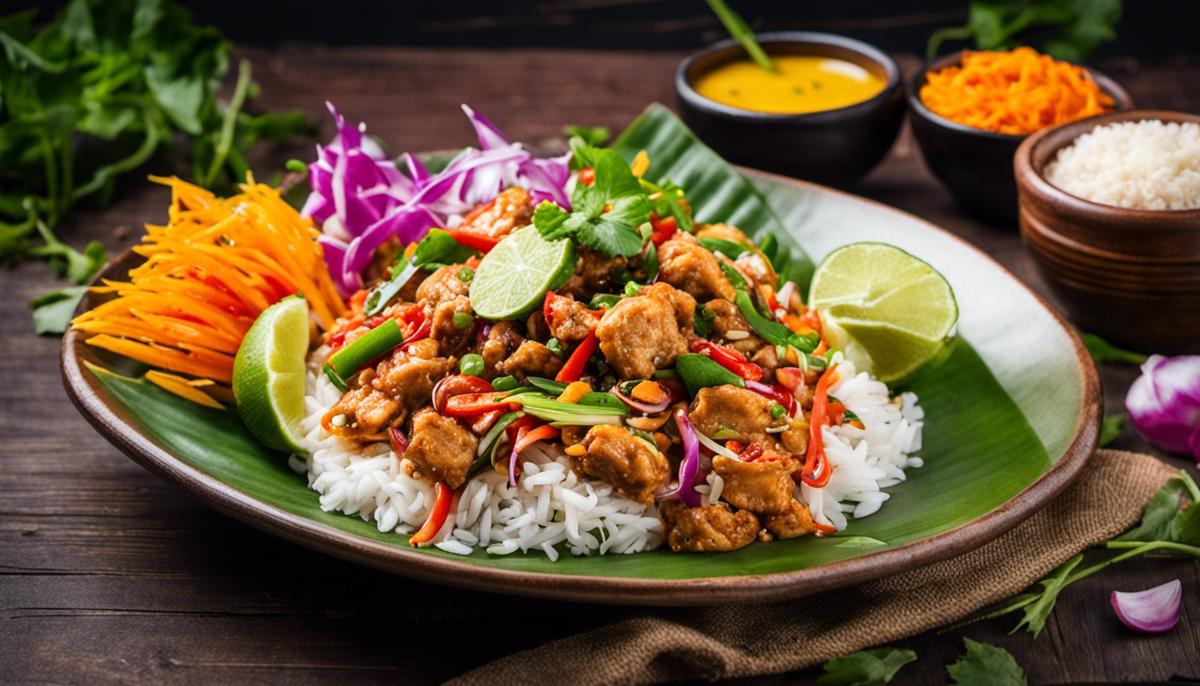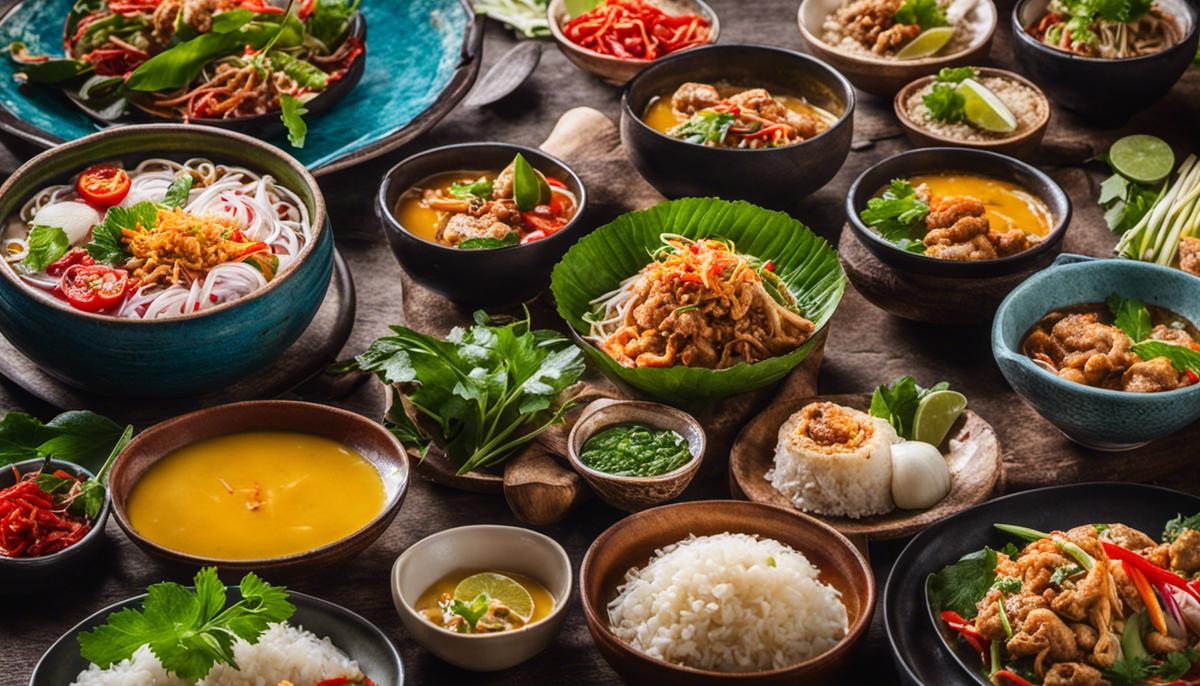Thai cuisine, a celebrated gastronomic treasure of Southeast Asia, offers a symphony of flavors and aromas that are as vibrant as the cultural history and traditions that shaped it. From its rich historical roots tinted with diverse cultural influences, to the life-giving herbs and spices that season its meals – the charm of Thai cuisine remains unparalleled. This exploration into the realm of Thai food seeks to journey through its beautiful complexity, examining its history and influences, scrutinizing essential ingredients, appreciating traditional dishes and recipes, and understanding regional variations and dining traditions. Brace yourself for an exhilarating foray into Thailand’s famed culinary landscape and allow yourself to be swept up in the ebullience and profundity it emanates.
History and Influences of Thai Cuisine
The Origins of Thai Food
The history of Thai cuisine stretches back to ancient times, strongly influenced by the country’s geographical location and vibrant mix of cultures. Historically, Thailand has been a thoroughfare for migration, trade, and invasion, resulting in a brilliant mixture of cultural influences impacting its gastronomy. Most consider the Sukhothai era (from the 13th to the 18th century) as the birth of essential Thai cuisine. During this period, the Thai people migrated from southern China to the fertile lands of today’s Thailand. Their initial cuisine was primarily Chinese-influenced, but gradually, as they discovered a wider array of ingredients like chili peppers, peanuts, and coconut milk, the distinctive flavors of Thai cuisine started to take form.
Impact of Indian Influence on Thai Food
Indian culture has also played a substantial role in shaping Thai food. Indigenous spices, together with Buddhism, were introduced to Thailand during the region’s Indianization in around the 3rd century BC. Indian influences can be seen in Thai curries, where spices are ground together with herbs to produce a paste, a method similar to the preparation of Indian curries. During the Ayutthaya period (14th to 18th century), trade with other countries intensified, bringing with it the integration of foreign cooking styles and ingredients. The addition of Indian spices such as turmeric, cumin, and coriander gave Thai cuisine its fragrant and heartwarming qualities that can still be experienced today.
Chinese Impact on Thai Cuisine
Chinese influence on Thai cuisine is evident in Thailand’s enormous variety of noodle dishes. The migration of Chinese merchants in the late Ayutthaya period led to the integration of Chinese cooking styles, especially stir-frying techniques and noodle-based dishes. Popular dishes like Pad Thai and Thai noodle soups resulted from this cultural integration.
Portuguese Influence on Thai Food
The 16th to 17th centuries saw the arrival of Portuguese traders and missionaries, who introduced new cooking methods and unfamiliar ingredients. The most famous Portuguese influence in Thai cuisine is seen in desserts. A classic example is the Thong Yip or ‘Pinched Gold’, an auspicious Thai dessert made chiefly from egg yolk, which was a significant culinary innovation from the Portuguese.
The Unfolding of Thai Cuisine
Over the span of centuries, Thai cuisine has developed and diversified, absorbing elements from various cultures to shape it into what we know and love today. This unique form of culinary art, truly representative of Thailand’s history, is famous for its balance of five fundamental flavors: spicy, sweet, sour, salty, and bitter. Today, Thai food is enjoyed across the globe for its bold taste profile and the variety of ingredients and flavors used. Each meal not only offers a delight for the taste buds but also acts as an entryway into Thailand’s rich cultural mosaic.

Fundamental Ingredients in Thai Food
Key Ingredients in Thai Cuisine
Famed globally, Thai cuisine is celebrated for its robust blending of flavors, and the interplay of the five core tastes: sweet, spicy, sour, bitter, and salty. The true credit for the depth and complexity of this cuisine belongs to a diverse array of fundamental ingredients used. Each of these ingredients adds a specific note, painting an overall gastronomical masterpiece that defines Thai food.
Fresh Herbs and Spices
Thai dishes predominantly use fresh herbs and spices, which are attributed with giving Thai food its distinct taste and aroma. The most commonly used herbs include basil (particularly Thai basil), cilantro, and mint. Each of these adds a characteristic flavor, with Thai basil providing a slightly spicy, aniseed-like aroma, mint adding a fresh, cooling effect, and cilantro contributing a zesty taste.
Spices and Heat
Additionally, spices play a crucial role, with many Thai dishes known for their heat. This heat comes from Thai chili peppers, which can range from mildly spicy to intensely hot. Apart from chili, garlic, galangal (Thai ginger), and turmeric are staples, with the latter giving dishes their vibrant yellow color.
Fruit in Thai Cuisine
Moreover, fruit is a key component of Thai culinary culture. Lime is often used to provide a sour flavor and can often be found in Thai salads, stir-fries, and curries. Other fruits, such as mango, pineapple, and papaya, are also frequently used in savory and sweet dishes.
Fish Sauce and Umami Flavor
Another quintessential ingredient in Thai cuisine is fish sauce, a salty, fermented sauce that adds a deep umami flavor to dishes. Made predominantly from anchovies and salt, fish sauce is to Thai cuisine what soy sauce is to Chinese.
Vegetables in Thai Cuisine
Vegetables also play a major role, not just as accompaniments but as main ingredients. Beyond commonly used vegetables like onions, bell peppers, and mushrooms, Thai cuisine is marked by the use of unique native vegetables such as Thai eggplant, morning glory, and yard-long beans.
Diverse Proteins
In terms of proteins, Thai cuisine is diverse, with dishes featuring chicken, beef, pork, and various types of seafood. Tofu and eggs are also frequent ingredients, catering to the vegetarian and vegan variants of certain dishes.
The Importance of Rice
And finally, no discussion of Thai food can be complete without mentioning rice. Jasmine rice is the most common variety, served alongside most Thai dishes. Thai cuisine also features glutinous or sticky rice, served with mango for a classic Thai dessert. Rice is also used in a fermented form to make rice noodles, a staple in dishes like Pad Thai.
Overview
The uniqueness of Thai food lies in its intricate blend of herbs, spices, vegetables, fruits, and proteins, creating a veritable symphony of flavors. This amalgamation of taste and fragrance forms the unmistakable identity of Thai cuisine which sets it apart globally.

Traditional Thai Dishes and Their Recipes
The Quintessential Tom Yum Goong
No discussion of Thai food would be complete without the mention of the famous Tom Yum Goong. This hot and sour shrimp soup, a favorite across Thailand, gets its unique taste from a mixture of native spices and ingredients such as lemongrass, kaffir lime leaves, galangal, and red chili peppers. The addition of fish sauce and lime juice contributes a perfect balance of umami, saltiness and sour notes. To amplify its comforting effect, especially in chilly weather, this soup is always served hot and usually adorned with a sprinkle of fresh cilantro.
Here’s how you can prepare Tom Yum Goong:
- Start by simmering lemongrass, kaffir lime leaves, galangal, and chili peppers in a pot of boiling water for approximately 15-20 minutes.
- Next, introduce the shrimp and mushrooms and let them cook until the shrimp acquires a pink hue.
- Now it’s time for the fish sauce and lime juice to make their entry.
- Finally, serve it hot, garnished with fresh cilantro for that final touch of flavor.
Pad Thai
Pad Thai is arguably the most recognizable Thai dish worldwide. It is a stir-fry noodle dish typically made with rice noodles, eggs, tofu or shrimp, and bean sprouts, all combined in a tangy, sweet, and sour sauce. The sauce typically includes tamarind paste, fish sauce, dried shrimp, garlic, red chili peppers, and palm sugar, topped with crushed peanuts.
To make Pad Thai:
- Soak the rice noodles according to package instructions.
- In a wok or large frying pan, stir-fry your choice of protein with garlic until cooked and set aside.
- Scramble the eggs and set aside.
- Stir-fry the noodles and add the sauce. Combine well.
- Add the cooked protein, scrambled eggs, and bean sprouts.
- Serve hot, garnished with crushed peanuts and a lime wedge.
Introducing Gaeng Keow Wan Kai
The traditional Thai dish Gaeng Keow Wan Kai, otherwise known as green curry chicken, is a quintessential part of Thai cuisine. This rich, creamy curry includes a coconut milk base, green curry paste, chicken, and an array of vegetables like Thai eggplants or bell peppers. The green curry paste itself is a unique melange of green chilies, lemongrass, galangal, and kaffir lime leaves.
Here’s how you can prepare Gaeng Keow Wan Kai at home:
- Initiate by heating the green curry paste in a pot until it releases its tantalizing aroma.
- Add in the chicken and cook it thoroughly until it’s beautifully browned.
- Pour in the coconut milk and introduce your choice of vegetables. Simmer this mixture until the chicken is thoroughly cooked and the medley of diverse flavors meld together perfectly.
- Serve this delectable treat piping hot with a side of jasmine rice to truly appreciate its flavors.

Eating Etiquettes and Dining Traditions in Thailand
A Deep-Dive into the Cultural Aspects of Dining in Thailand
Thai dining culture is a unique blend of communal interaction and social camaraderie. Rather than being served in courses, Thai meals come out all at once. A traditional Thai meal harmonizes around five central elements: a warming soup, a delectable curry dish with condiments, a dip partnered with fish and fresh vegetables, a hot salad, and a selection of decadent sweets or desserts.
The significance of rice in a Thai meal can’t be overstated. Customarily cooked to be soft and sticky, it is easily picked up with the customary eating utensils – a fork and a spoon. Unlike Western practices, Thai culture prefers using a fork to guide food onto the spoon, which is then brought to the mouth. The use of a knife is not typical, as food is mostly served in bite-sized portions or can be comfortably broken with a spoon and fork.
One can’t ignore the balance of the four key flavors – sweet, sour, salty, and spicy – in Thai cuisine. Thai food aims to strike a harmony among these diverse flavors, either in a single dish or across the entire meal. Each dish is made to be shared, ensuring that every diner gets a whirlwind tour of the various textures and flavors in every bite.
Unique Customs and Traditions in Thai Dining
In Thailand, eating alone is perceived as bad luck. Therefore, meals are often a communal affair, and it is common to share many types of dishes with others. Moreover, it’s traditional to honor guests by serving them first and offering the tastiest ingredients of a shared meal.
It is also customary to always leave a little food on your plate when you’re finished eating to show that you are satisfied. Cleaning your plate entirely can suggest that you’re still hungry.
Thai food culture embraces the street food scene, with street food stalls and markets being an integral part of Thailand’s culinary landscape. These stalls often offer a variety of dishes from different regions of Thailand, allowing locals and tourists alike to experience a wide array of Thai cuisine.
The Thai food culture also extends to beverages. Several traditional Thai drinks accompany meals, such as the sweet, iced tea known as Cha Yen, or refreshing coconut water. Sometimes, fragrant pandanus leaf water is served at the end of a meal to aid digestion.
An Introduction to Thai Food Culture
Encompassing far more than just delectable dishes, Thai food offers a robust blend of social and cultural insights. The shared dining experiences, distinctive customs and traditions, and an array of flavors all combine to create a Thai food culture that is immeasurably rich and immersive.

Photo by brookelark on Unsplash
Exploring Regional Variations of Thai Food
Diversity in Thai Cuisine across Regions
Representative of Thailand’s diverse geography, history, and regional cultures, Thai cuisine varies distinctly across the country’s major regions. These regions, which include Northern Thailand, Northeastern Thailand (Isan), Central Thailand, and Southern Thailand, each serve up unique culinary delights. These gastronomic variations are largely influenced by their proximity to neighboring countries and the region’s available resources.
Northern Thai Cuisine
Northern Thai cuisine is characterized by mild and creamy flavors, typically using ingredients available in the cool, forested mountains. The region is landlocked, so dishes do not have as much fish or shellfish but instead feature hearty ingredients like pork, chicken, and various vegetables. The classic Northern Thai dish is ‘Khao Soi’, a coconut cream curry with noodles and meat, often garnished with lime, pickled mustard greens, shallots, and crispy noodles on top. Another popular dish is ‘Nam Prik Ong’, a spicy tomato and minced pork dip served with fresh and steamed vegetables.
Isan (Northeastern) Thai Cuisine
Isan cuisine comes from Northeastern Thailand and is heavily influenced by Laos, located to the north. Sticky rice is a staple food in this region, often served with grilled meats, ‘Som Tam’ (spicy green papaya salad), and ‘Larb’ (minced meat salad), with abundant use of fresh herbs, vegetables, and fish sauce. The food here is known for its spiciness and pungent flavors, often fermented.
Central Thai Cuisine
Central Thai cuisine is what many Westerners perceive as ‘Thai food’. The food in this region is a blend of flavors from all over the country, but with a more Chinese influence. The dishes are well-balanced with sweet, sour, salty, and spicy flavors. The region is known for its ‘Pad Thai’ (stir-fried noodles), ‘Kaeng Kheow Wan’ (green curry), and ‘Tom Yam Goong’ (hot and sour prawn soup). The area has abundant rice fields and access to the sea, resulting in dishes rich in rice, fish, and seafood.
Southern Thai Cuisine
Southern Thai cuisine is known for its pronounced spicy and vibrant flavors with a generous use of herbs and spices, many of which have Arabic and Indian influences due to the historical spice trading routes. The food here has a focus on seafood from the plentiful coastal waters and also features coconut milk and palm sugar. Famous dishes include ‘Massaman Curry’ (a rich, sweet, and savory curry with meat and potatoes) and ‘Kaeng Som’ (a sour and spicy fish soup).
Given Thailand’s diversity, Thai cuisine is a melange of flavors and ingredients. The regional variations combine to create the rich tapestry of dishes that we know as Thai food today. Historical influences from neighboring regions and countries, geographical factors like climate and topography, and cultural elements such as religion and social structure all play a crucial role in shaping Thai cuisine.

Thus, Thai cuisine, in its richness and variety, offers an ecstatic gastronomic experience that is a true reflection of Thailand’s vibrant culture, history, and diversity. It represents an agglomeration of fiery spices from the south, milder flavors from the north, myriad influences from India, China, and Portugal, punctuated by unique Thai twists. Beyond the diverse range of flavors and ingredients, Thai food equally embodies the ethos of Thai culture, laying great emphasis on balance, detail, and the underlying philosophy of sharing. So, whether you are changing your palate by cooking Thai at home, or diving into the Thai food culture on a street in Bangkok, you can be sure to get more than just a meal, but a delightful experience that reaches deep into the heart of Thai culture.
